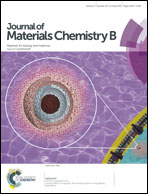Evaluation of the role of polyelectrolyte deposition conditions in growth factor release†
Abstract
Polyelectrolyte multilayer coatings were prepared from solutions of poly(methacrylic acid) and poly-L-histidine. Bone morphogenetic protein 2 (BMP-2) was adsorbed onto the surface of anodized titanium and polyelectrolyte multilayer coatings were built up on top of the BMP-2. The effect of deposition conditions on coating properties and preosteoblast response was measured by comparing coatings prepared under natural conditions to those prepared from solutions at pH = 6.0 and solutions containing 0.1 M NaCl. High levels of BMP-2 release were achieved, with coatings prepared from pH = 6.0 solutions releasing 86 ng cm−2 and coatings prepared from solutions containing 0.1 M NaCl releasing 114 ng cm−2 over 25 days. Enhanced preosteoblast differentiation was observed on coatings prepared from modified solutions; however, this increased differentiation was apparent for BMP-2-eluting and control coatings. Additionally, a positive relationship between surface roughness and differentiation was observed, which may account for increased differentiation for systems that do not release BMP-2.


 Please wait while we load your content...
Please wait while we load your content...